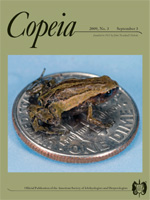How climate change may affect parasite–host assemblages and emerging infectious diseases is an important question in amphibian decline research. We present data supporting a link between periods of unusually warm summer water temperatures during 2006 and 2008 in a northern California river, outbreaks of the parasitic copepod Lernaea cyprinacea, and malformations in tadpoles and young of the year Foothill Yellow-legged Frogs (Rana boylii). Relative to baseline data gathered since 1989, both 2006 and 2008 had significantly longer periods when daily mean water temperatures exceeded 20°C compared to years without copepod outbreaks. Infestation varied spatially in the watershed, as prevalence increased concomitantly with temperature along a 5.2 km longitudinal transect. At breeding sites of R. boylii with copepods in 2006, infestation ranged from 2.9% of individuals upstream to 58.3% downstream. In 2008, copepods were absent from the most upstream sites and infested up to 28.6% of individuals sampled at downstream locations. Copepods most frequently embedded near a hind limb or the cloaca. Among individuals with parasites in 2006, 26.5% had morphological abnormalities compared to 1.1% of un-infested individuals. In 2008 when the infestation peak occurred late in development (post Gosner stage 39), abnormalities were not associated with copepod infestation. In both years, recently metamorphosed frogs with copepods were, on average, slightly smaller than those not infested. These occurrences represent a sudden increase in local prevalence atypical for this river ecosystem. Previously we had only once seen copepods on amphibians (on non-native Bullfrogs, Rana catesbeiana), six km further downstream. Pacific Chorus Frogs, Pseudacris regilla, which co-occur with R. boylii in shallow near shore habitats were not used as hosts. The data suggest that increasing summer water temperatures, decreased daily discharge, or a combination of both, promote outbreaks of this non-native parasite on an indigenous host, and could present a threat to the long-term conservation of R. boylii under the flow regime scenarios predicted by climate change models.
How to translate text using browser tools
3 September 2009
Parasitic Copepod (Lernaea cyprinacea) Outbreaks in Foothill Yellow-legged Frogs (Rana boylii) Linked to Unusually Warm Summers and Amphibian Malformations in Northern California
Sarah J. Kupferberg,
Alessandro Catenazzi,
Kevin Lunde,
Amy J. Lind,
Wendy J. Palen
ACCESS THE FULL ARTICLE

Copeia
Vol. 2009 • No. 3
September 2009
Vol. 2009 • No. 3
September 2009




